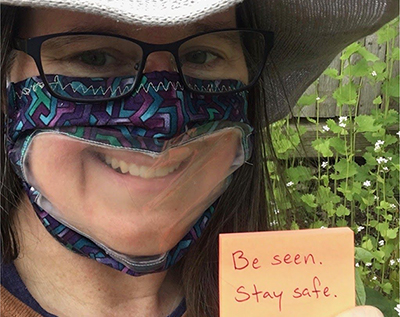Visible Mask Pattern by Meguey Baker

Here's Meguey's pattern for a Visible Mask, a personal protective mask with a transparent panel, to support people who are hard of hearing, read lipis, or who otherwise depend on visual cues to communicate. She made it for and with the consultation of our friend Alexandra, an audiologist whose clients are mostly elderly and at risk, who needs a way to protect herself and them while fitting and testing their hearing aids.
Visible Mask: Pattern by Meguey Baker (pdf)
Visible Mask: Pattern by Meguey Baker (html)
Also, friends, thank you for sticking with us during these strange and bad times! For us, game design has never been an escape or a refuge from reality. We've always considered our game design work to be a part of our pro-justice, pro-peace, pro-empowerment activism. Thank you for making it all possible.
Meguey's Design notes for Visible Mask:
One of the most valuable things I’ve learned as a game designer is iteration. Build a testable thing, test it, revise, test again, and again, until it works the way I intend it to or I determine it is not a viable solution to the problem at hand. Usually, it’s not a matter of actual physical health and safety. With Visible Mask, it is. Alexandra asked me to make personal protective equipment in a highly specialized way, quickly, because she was about to put her life, and her family's life, and therefore, because our sons are best friends, my family’s life, in my hands, at least so far as keeping her able to wear PPE while doing her job.
We all know that pleated masks are to keep the WEARER’s germs from getting on OTHER PEOPLE, but there are also some real benefits to stopping the wearer from touching infected surfaces and then their face. So, testing, intensely.
I spent a full day testing different clear plastics to see what would withstand washing and drying, thinking hard about how to seal the stitching lines. I wanted to be at the next step, but I HAD to get the clear part right - find a material that wouldn’t perforate, or be too rigid, or melt, or become cloudy or crackle. Doing 8 loads of laundry didn’t feel like design work, but it was critical to the success of the project. It wasn’t until showering that night that I hit on the obvious answer: clear shower curtain liners, built to withstand plenty of hot washes!
A second really important piece of game design I brought to this process was patience while looking for solutions. A lot of people are making masks. I’d looked at at least a dozen patterns. I have masses of fabric. What I didn’t have was elastic. Patience. What else could I use?
Near the beginning of this, I made masks for our family and Alexandra’s using hair ties for loops, enough for our households. Then I ran out of hair ties and realized I was not nearly as fast at sewing masks as my friends who were running out of fabric. Patience. How else could I help?
I started cutting and mailing out mask blanks ready to sew, about 500 of them, plus uncut yardage. I felt glad to have helped, but it wasn’t direct and local. Patience. Where could I help locally?
My quilt guild is mostly retirees who did not want to risk more outtings than absolutly needed; I offered to run masks from their homes to the hospital collection point. Then I made the connection to t-shirt yarn for ties, and things started to click; I asked my extended family if they needed masks and made a dozen more, using combinations of various patterns to make a solid cloth version of the Visible Mask. THEN Alex asked if I could make a Visible Mask; I hadn’t yet, but I knew I could.
This process of active waiting, keeping focused on the design questions as the pieces fall into place as you go about your daily life, is rarely fun. It can feel like you are stalled out or doing nothing, even when in retrospect all the design work was happening. Sometimes being patient WHILE iterating on your design is the hardest part, especially when the design is so important to you.